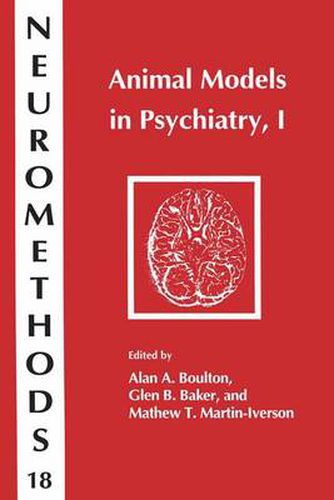Readings Newsletter
Become a Readings Member to make your shopping experience even easier.
Sign in or sign up for free!
You’re not far away from qualifying for FREE standard shipping within Australia
You’ve qualified for FREE standard shipping within Australia
The cart is loading…






This title is printed to order. This book may have been self-published. If so, we cannot guarantee the quality of the content. In the main most books will have gone through the editing process however some may not. We therefore suggest that you be aware of this before ordering this book. If in doubt check either the author or publisher’s details as we are unable to accept any returns unless they are faulty. Please contact us if you have any questions.
The two Animal Models in Psychiatry volumes are loosely organized by subject. The first volume contains a number of chapters concerned with schizophrenia, psyc- ses, neuroleptic-induced tardive dyskinesias, and other d- orders that may involve dopamine, such as attention deficit disorder and mania. The second volume deals with affective and anxiety disorders, but also includes chapters on subjects not easily classified as either psychotic, or affective, or an- ety-related, such as aggression, mental retardation, and memory disorders. Four chapters on animal models of schizophrenia or psychoses are included in the present v- ume because of the importance of these disorders in p- chiatry. Likewise, three chapters in the subsequent volume deal with depression. The first of the two volumes begins with an introd- tion by Paul Willner reviewing the criteria for assessing the validity of animal models in psychiatry. He has written - tensively on this subject, and his thorough description of the issues of various forms of validity provides a framework in which to evaluate the subsequent chapters. As will be seen, the remaining chapters in both volumes will refer frequently to these issues. The second chapter, by Melvin Lyon, describes a large number of different procedures that have been p- posed as potential animal models of schizophrenia. This is a departure from the usual format, consisting of detailed - scriptions of specific models.
$9.00 standard shipping within Australia
FREE standard shipping within Australia for orders over $100.00
Express & International shipping calculated at checkout
This title is printed to order. This book may have been self-published. If so, we cannot guarantee the quality of the content. In the main most books will have gone through the editing process however some may not. We therefore suggest that you be aware of this before ordering this book. If in doubt check either the author or publisher’s details as we are unable to accept any returns unless they are faulty. Please contact us if you have any questions.
The two Animal Models in Psychiatry volumes are loosely organized by subject. The first volume contains a number of chapters concerned with schizophrenia, psyc- ses, neuroleptic-induced tardive dyskinesias, and other d- orders that may involve dopamine, such as attention deficit disorder and mania. The second volume deals with affective and anxiety disorders, but also includes chapters on subjects not easily classified as either psychotic, or affective, or an- ety-related, such as aggression, mental retardation, and memory disorders. Four chapters on animal models of schizophrenia or psychoses are included in the present v- ume because of the importance of these disorders in p- chiatry. Likewise, three chapters in the subsequent volume deal with depression. The first of the two volumes begins with an introd- tion by Paul Willner reviewing the criteria for assessing the validity of animal models in psychiatry. He has written - tensively on this subject, and his thorough description of the issues of various forms of validity provides a framework in which to evaluate the subsequent chapters. As will be seen, the remaining chapters in both volumes will refer frequently to these issues. The second chapter, by Melvin Lyon, describes a large number of different procedures that have been p- posed as potential animal models of schizophrenia. This is a departure from the usual format, consisting of detailed - scriptions of specific models.